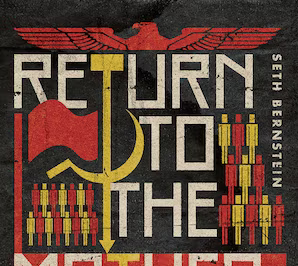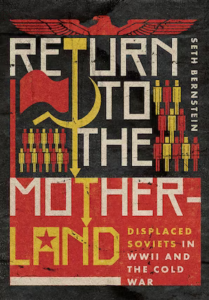
Return to the Motherland: Displaced Soviets in World War II and the Cold War by Seth Bernstein

There were more than seven million Russian civilian forced laborers and POWs deported to work for the Germans and their allies during WWII. In Germany, these workers were called Eastern Workers (Ostarbeiter) and POWs. In postwar Europe, they became displaced persons. Those who returned to the Soviet Union became repatriates (repatrianty). Those who refused to come back to the USSR became “nonreturners” in Allied-occupied Europe. Soviet accounts put the number of nonreturners at 450,000, but they were possibly more numerous (2).
Today, in the context of the war in Ukraine, Russian state policies towards expatriates, repatriates, and forcibly deported people in the Eurasian space are as relevant as ever. Recent events have demonstrated the various approaches taken by state agents in Russia towards Russian citizens who have fled the country en masse since the war started and especially towards those who are unable to survive physically or emotionally in their emigration experience and end up returning. In Russia, the emotions of most people towards these people have been negative and reminiscent of an old Soviet discourse. The people who have fled have been accused of treason and collaboration with the enemy. Recent mass relocations have also coincided with the development of new means to govern, control, and mobilize the population through modern, digital technology
In Return to the Motherland: Displaced Soviets in World War II and the Cold War, Seth Bernstein offers a solid study contributing to the history of forced migrations and large-scale population displacements in Central and Eastern Europe after 1939. He focuses on Soviet forced laborers and prisoners of wars (POWs) during and after the second World War, resurrecting from oblivion the “suppressed repatriates’ story of the war.” Bernstein argues that under Stalin, returnees were persecuted and that they met with a cold reception in Soviet society, as they were forced into hard labor to pay for their perceived disloyalty. The author explains that this policy did not allow them to re-integrate into Soviet society, as ordinary people avoided contact with them in fear of being arrested as traitors and spies themselves, while the Russian police considered repatriates as collaborators and spies for years after their return. To support his argument, Bernstein uses archival evidence released in the 2010s in Russia and Ukraine—in particular the secret police’s investigations of repatriates from Ukraine—to humanize the experience of forced labor and repatriation and uses personal histories to provide a renewed understanding of wartime displacement and its aftermath. Connecting Soviet displacement policies to the history of wartime and postwar Europe, Bernstein also studies how individual ideological preferences became blurred.
Comparing the history of mass displacements in modern authoritarian regimes and the experience of the people who leave their country and return home is particularly valuable in the context of today’s war in Ukraine. However, Russia is not the only authoritarian regime in the world, as such regimes have been a pan-European phenomenon. The management of mass displacements, ethnic cleansing, or forced labor, have been customarily associated with the “dark side of modernity”; and all modernizing empires (in Europe and beyond) and their successor nation-states engaged in population politics in the late nineteenth and early twentieth century,[1] leading to the use of forced labor policies and increased state interventions.
The modern Eurasian empires and their successor states were the most enthusiastic participants in the testing of intrusive and radical strategies of population management.[2] During and in the aftermath of WWI, there were massive deportations and population displacements on the Eastern front.[3] After this large-scale “population exchange”,[4] other flows followed, such as the those of the Jews leaving Germany, of those being deported to the Soviet Gulag, those falling victims to ethnic deportations, and, finally, people fleeing the Holocaust. Indeed, WWI led to new and radical methods of governance in the two rival “forced labor” empires—Germany and Soviet Russia—and intensified forced mobilization, deportations, and ethnic cleansing. The line between ethnic cleansing, massive political repression, forced deportations, and voluntary migrations in many cases was blurred, and studies such as Bernstein’s, which are based on regional documents and personal accounts, are valuable to tell this history from the perspective of the people.
Therefore, this study has important implications. It shows that the experiences of the returnees had the “unintended” effect of weakening the ideological foundations of “forced labor empires.” In particular, Bernstein claims that Eastern Workers and POWs were released from the ideological strictures of Stalinism, which allowed them to shed their Soviet identity. Instead, identities based on kinship, regional belonging, or which barrack they lived in emerged to define social life in labor camps. In spite of the cruelty Eastern Workers and POWs faced, their life experience contravened the Stalinist xenophobia of the 1930s that prohibited ordinary Soviet citizens to have any contact with foreigners. In Germany and then the Soviet Union, POWs could collaborate or resist based on pragmatic considerations rather than ideological preferences. As Bernstein describes, Soviet displacement policies indeed presented a serious challenge to social order. The author sets new horizons for the current scholarly “deconstruction” of the authoritarian regimes of the twentieth century as inherently modern. He shows how a certain vacuum emerged at the end of the war in 1945 in the control states had over their citizens across Europe and that the tumultuous postwar situation allowed individuals and groups, including Soviet deportees, to cultivate and preserve new fluid identities.
Focusing primarily on different forms of suffering of male and female repatriates in his descriptions of personal histories, Bernstein devotes himself to what Paul Valéry called “digging up and exhibiting the decapitated heads of a tragic age,” following a popular trend in the study of forced migrations under authoritarian regimes. As a result, the heterogeneity of the ethnic, social, and cultural fabric of post-war Soviet deportees somehow evades the narrative. For example, how did POWs perceive the experience of ethnic Russians, Ukrainians, and ethnic minorities? Bernstein also seems to ignore the broader historiographical context. Indeed, many Western and Russian scholars have already uncovered the general history of forced relocations, deportations, and forced labor and their influence on the reconstruction of collective and individual identities.[5] These scholars have also explained important factors in relation to identity reconstruction and blurring that took place through the forced relocation of various groups of population, including that of people deemed “guilty” who were moved to areas of special settlement or exiled internally. These areas were most often located in the northern and eastern regions of the USSR,[6] mostly in Kazakhstan, western Siberia, the Urals, the northern stretches of European Russia, and Central Asia.[7]
These historiographical contexts show that the sites to which the Soviets—as well as the Germans—deported laborers by force became a unique universe, where a double process of identity construction developed. On the one hand, as Bernstein amply demonstrates, small daily acts of resistance sprung and flourished. This “daily dissent” weakened the ideological pillars of dictatorships. On the other hand, traditional values—such as a concern for property ownership, patriarchal traditions, power, land, freedom, and adherence to communal customs—were also weakened in the “melting pot” of “forced labor empires.” People’s national self-awareness also diminished as they came into contact with “modern” and ideologically aggressive Soviet and German “population management” policies.[8] Many religious and family traditions ceased to exist, and various new, universally modern models of behavior emerged. For example, the usual norms and cultural codes of communism were adapted by different types of “relocants” differently. At the same time, behind the façade of Soviet and German official slogans—as reflected in the secret services’ official reports—the remnants of patriarchal communities became engrained in radically new forms of dependency, relationships, legal norms, and hierarchies in the forced labor enclaves.
Bernstein opens his book with words by Vassily Grossman: “No one is forgotten, no one is forgiven,” which acquire a macabre connotation under the current circumstances. Indeed, the Russian state has expressed increased concerns about recent Russian relocants and applied a “carrot and stick” policy combining public threats with unreal promises to lure them back.
Oksana Ermolaeva has a PhD in history from the Central European University (Budapest, Hungary). She is a recipient of the Gerda Henkel Scholar’s at Risk grant, 2023 – 2024. Her research focuses on the social, cultural, and environmental entanglements of I. Stalin’s Gulag (a regional case-study).
Return to the Motherland: Displaced Soviets in World War II and the Cold War
By Seth Bernstein
Publisher: Cornell University Press
Hardcover / 312 pages / 2023
ISBN: 9781501767395
[1] Peter Holquist, “To Count, To Extract, and To Exterminate: Population Statistics and Population Politics in Late Imperial and Soviet Russia,” in A State of Nations: Empire and Nation-Making in the Age of Lenin and Stalin, eds. Terry Martin and Ronald G. Suny (New York: Oxford University Press, 2001), 111–144; A. Rieber, Stalin and the Struggle for Supremacy in Eurasia, 243–282.
[2] Alfred J. Rieber, ed. Forced Migration in Central and Eastern Europe, 1939–1950 (London: Frank Cass Publishers, 2000).
[3] Eric Lohr, Nationalizing the Russian Empire: The Campaign against Enemy Aliens During World War I (Cambridge, MA: Harvard University Press, 2003); Peter Gatrell, A Whole Empire Walking: Refugees in Russia during World War I (Bloomington: Indiana University Press, 1999 / 2005).
[4] Nick Baron and Peter Gatrell, eds., Homelands: War, Population and Statehood in Eastern Europe and Russia, 1918–1924 (London: Anthem Press, 2004).
[5] See for example Dittmar Dahlmann, “Operation erfolgereich durchgefurht”: Die Deportationen der Wolgadeutschen 1941,” in Flucht und Vertreibung: Zwichen Aufrechtung und Verdrängung (Vienna: Picus, 1994); Alfred Eisfeld and Victor Herdt, Deportations, Sonderseidlung, Arbeitsarmee: Deutsche in der Sowjetunion 1941 bis 1956 (Cologne: Wissenschaft und Politik, 1996); Michael Gelb, “The Western Finnic Minorities and the Origins of the Stalinist Nationalities Deportations,” Nationalities Papers 24, 2 (1996): 237–68.
[6] Zemskov, Spetsposelentsy v SSSR, 1930–1960, 205. Lynne Viola, “The Aesthetics of Stalinist Planning and the World of Special Villages,” Kritika 4, 1 (2003): 101–28.
[7] For example, a total of 258,448 families—959,472 individuals—lived in these settlements. (V. Ia. Shashkov and S. S. Kozlov, “Spetspereselentsy na zashchite otechestva,” Voprosy istorii, no. 5 (2005): 158–63). By 1 January 1953, the number of special settlers had grown to 2,753,356. V. Berdinskikh, Spetsposelentsy, 57.
[8] V. Berdinskikh, Spetsposelentsy, 268–76.
Published on September 12, 2023.




